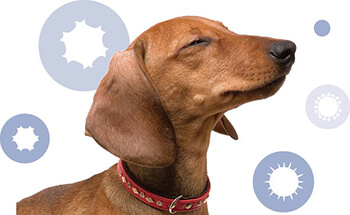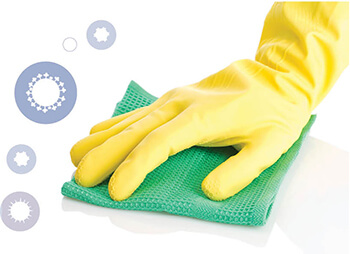
Dangers of Indoor Air Quality
By Annette Uda
Having a better understanding of the kind of animal diseases that can be transmitted by air can help individuals effectively deal with airborne disease transmission as well as in selecting the right decontamination methods to be used. The most common animal diseases are known to be airborne or transmitted by air. These are not limited to but include Canine influenza, Bordetella, Feline Calicivirus, Canine Parvovirus, Canine Coronavirus, and Canine Distemper virus.
Interestingly, 98% percent of the particles, in typical indoor air, are 3 microns or smaller in size. Many zoonotic pathogens, including the ones listed above, are less than 1 micron in size. This is important because the smaller the particle size the easier it is for germs and infection to spread throughout your facility. Many of these microorganisms can easily attach and circulate on dust particles.
Many pathogens are transmitted by direct contact between animals or between animals and human-beings. Airborne respiratory infections can easily be inhaled or cause infection via the mouth, nose or eyes. Special attention should be emphasized when a flu virus sweeps through humans or infects staff members in animal care facilities, as such diseases may be transmitted to and from animals. Any outbreak that’s caused by airborne pathogens can be very explosive.
Cleaning surfaces in animal care facilities will greatly reduce transmission rates of airborne diseases and improve indoor air quality. And anything done to provide clean air will mitigate airborne transmission. Major pathogens that can be transmitted among animals by air include fungi, bacteria, and viruses.
The most ideal way of dealing with the indoor transmission of airborne disease is through the implementation of a two-pronged approach that combines air cleaning and surface cleaning. Interior surfaces of an animal care facility should be cleaned, disinfected, and washed, because larger airborne microbes tend to settle out of the air to mostly horizontal surfaces such as furniture or the floor. Common cleaning procedures are adequate and will normally include washing surfaces with disinfectants and detergents regularly.
Another popular, yet highly effective method of improving air quality in animal care facilities is to use properly sized Ultra Violet Germicidal Irradiation (UVGI). Using UVGI for airborne disinfection has long been used in hospitals, government agencies, and surgery rooms for over 50 years. This kind of technology has proved very effective in animal care facilities, destroying over 99 percent of animal-related pathogens. UV systems can be easily installed and will efficiently and effectively disinfect the air of bacteria and viruses as well as help eliminate mold inside ventilation areas.

Cleaning the air using air filters can also help in the elimination of fungal spores, microbes and pollen which have the potential to cause allergies from indoor air, given the appropriate filters are used. The use of both UV air disinfection and air filtration offers a cost-effective way to clean ventilation air as well as reduce the transmission of airborne diseases.
For pet boarding, daycare centers, and indoor kennels, the use of UV lamps combined with air filtration can greatly supplement existing cleaning procedures and offer the best means to mitigate the spread of air airborne diseases among animals, from humans to animals, from animals to humans, and from the environment to animals.
Creating ventilation is another important factor with the ability to have an effect on the relationship between the health of animal care facility staff and the airborne transmission of respiratory infections. Animal care facilities are regarded as being of high risk and are different from medical or other human occupancy facilities.
Animal care facilities have similar air quality issues with other institutions like hospitals. They share concerns about airborne bacteria and pathogens, particularly for animal patients just like hospitals for humans. However, animal care facilities also need to go further and control odor problems which can be severe without the right purification and ventilation. Poor indoor air quality may cause animals to contract diseases in facilities. Unpleasant odors can make an animal care facility an uncomfortable place for both pets and their owners.
Animal care facilities generally tend to be more susceptible to air contaminants like dust and dander, airborne illnesses, and ammonia. Pets entering facilities for care are very vulnerable to such contaminants, but some will also be dangerous to personnel health as well. Dust and dander causes allergic reactions and discomfort among those visiting or working in animal care facilities. Among the most common contaminants in animal care facilities are; airborne viruses and bacteria, unpleasant odors, dust, and cleaning chemicals.

Air conditioners and central heaters have filters designed to trap pollutants and dust in the air. It is highly recommended to clean or change filters on a regular basis. When searching for an Ultraviolet germicidal irradiation air cleaning company, it is vital to ask how they size a facility as well as to ask to see their kill rates on zoonotic pathogens along with their test results.
Surface disinfection and surface cleaning accompanied with air filtration and air disinfection can go great lengths to provide the cleanest air and healthiest possible facility for both animals and personnel working there. There are currently no established levels for indoor air quality, but more advanced and sophisticated air cleaners such as properly sized UV will provide higher levels of air cleanliness that’s sufficient to lower disease transmission rates to their lowest levels.
Annette is the founder of PetAirapy, LLC, an Illinois-based company manufacturing advanced commercial-grade Air and Surface disinfection units by means of Ultraviolet Germicidal Irradiation (UVGI). Annette has a passion for promoting the health and well-being of all animals through raising awareness of the importance of indoor air quality. Through research and development along with a team of doctors and engineers, she has been able to identify and mitigate over 200 Animal specific micro-organisms that can spread illness throughout animal care facilities. PetAirapy products have been tested & proven to kill over 99.9% of viruses, bacterias and germs including K-9 cough, Distemper, Canine influenza, Feline calicivirus and more. PetAirapy units are widely used in many animal hospitals, shelters, boarding facilities and more.


